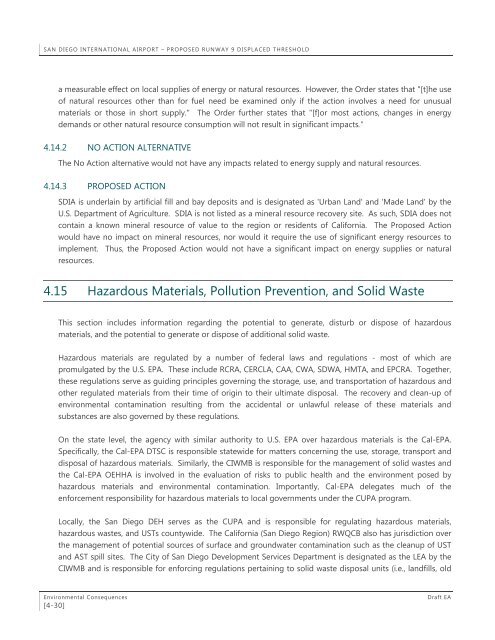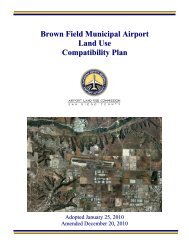Draft EA - San Diego International Airport
Draft EA - San Diego International Airport
Draft EA - San Diego International Airport
You also want an ePaper? Increase the reach of your titles
YUMPU automatically turns print PDFs into web optimized ePapers that Google loves.
SAN DIEGO INTERNATIONAL AIRPORT – PROPOSED RUNWAY 9 DISPLACED THRESHOLD<br />
a measurable effect on local supplies of energy or natural resources. However, the Order states that "[t]he use<br />
of natural resources other than for fuel need be examined only if the action involves a need for unusual<br />
materials or those in short supply." The Order further states that "[f]or most actions, changes in energy<br />
demands or other natural resource consumption will not result in significant impacts."<br />
4.14.2 NO ACTION ALTERNATIVE<br />
The No Action alternative would not have any impacts related to energy supply and natural resources.<br />
4.14.3 PROPOSED ACTION<br />
SDIA is underlain by artificial fill and bay deposits and is designated as 'Urban Land' and 'Made Land' by the<br />
U.S. Department of Agriculture. SDIA is not listed as a mineral resource recovery site. As such, SDIA does not<br />
contain a known mineral resource of value to the region or residents of California. The Proposed Action<br />
would have no impact on mineral resources, nor would it require the use of significant energy resources to<br />
implement. Thus, the Proposed Action would not have a significant impact on energy supplies or natural<br />
resources.<br />
4.15 Hazardous Materials, Pollution Prevention, and Solid Waste<br />
This section includes information regarding the potential to generate, disturb or dispose of hazardous<br />
materials, and the potential to generate or dispose of additional solid waste.<br />
Hazardous materials are regulated by a number of federal laws and regulations - most of which are<br />
promulgated by the U.S. EPA. These include RCRA, CERCLA, CAA, CWA, SDWA, HMTA, and EPCRA. Together,<br />
these regulations serve as guiding principles governing the storage, use, and transportation of hazardous and<br />
other regulated materials from their time of origin to their ultimate disposal. The recovery and clean-up of<br />
environmental contamination resulting from the accidental or unlawful release of these materials and<br />
substances are also governed by these regulations.<br />
On the state level, the agency with similar authority to U.S. EPA over hazardous materials is the Cal-EPA.<br />
Specifically, the Cal-EPA DTSC is responsible statewide for matters concerning the use, storage, transport and<br />
disposal of hazardous materials. Similarly, the CIWMB is responsible for the management of solid wastes and<br />
the Cal-EPA OEHHA is involved in the evaluation of risks to public health and the environment posed by<br />
hazardous materials and environmental contamination. Importantly, Cal-EPA delegates much of the<br />
enforcement responsibility for hazardous materials to local governments under the CUPA program.<br />
Locally, the <strong>San</strong> <strong>Diego</strong> DEH serves as the CUPA and is responsible for regulating hazardous materials,<br />
hazardous wastes, and USTs countywide. The California (<strong>San</strong> <strong>Diego</strong> Region) RWQCB also has jurisdiction over<br />
the management of potential sources of surface and groundwater contamination such as the cleanup of UST<br />
and AST spill sites. The City of <strong>San</strong> <strong>Diego</strong> Development Services Department is designated as the L<strong>EA</strong> by the<br />
CIWMB and is responsible for enforcing regulations pertaining to solid waste disposal units (i.e., landfills, old<br />
Environmental Consequences<br />
[4-30]<br />
<strong>Draft</strong> <strong>EA</strong>
















